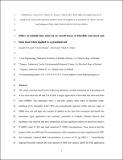| dc.contributor.author | Lucid, Joseph D. | |
| dc.contributor.author | Healy, Mark G. | |
| dc.date.accessioned | 2014-07-24T08:56:06Z | |
| dc.date.available | 2014-07-24T08:56:06Z | |
| dc.date.issued | 2014 | |
| dc.identifier.citation | Lucid, J.D., Fenton, O., Grant, J., Healy, M.G. (2014) 'Effect of rainfall interval on runoff losses of biosolids and meat and bone meal when applied to a grassland soil'. Water Air And Soil Pollution, 225 (8). | en_US |
| dc.identifier.uri | http://hdl.handle.net/10379/4455 | |
| dc.description.abstract | This study assessed runoff losses following laboratory rainfall simulation on a grassland soil at two time intervals (48 and 216 h) after a single application of biosolids and meat and bone meal (MBM). The treatments were: a soil-only control, three types of biosolids (lime-stabilised (LS), thermally dried (TD) and anaerobically digested (AD)) and two types of MBM (low ash and high ash content) all applied at two rates (the maximum and double the maximum legal application rate currently permitted in Ireland). Results showed that treatment, time interval and their interactions all had significant effects on dissolved reactive P (DRP), total P (TP) and total dissolved P (TDP) concentrations. Time interval had the greatest effect for DRP and TP concentrations, while treatment was more significant for TDP. All treatments released DRP concentrations in excess of 30 µg DRP L-1. Anaerobically digested biosolids released the least amount of DRP into surface runoff for both application rates at both time intervals. Low ash-content MBM, applied at the maximum legal rate, released the most DRP at both time intervals, and the TD biosolids released the most DRP when applied at double the maximum rate. Lime-stabilised biosolids released the most TP in runoff at both application rates. Runoff comprised > 50% particulate P for all treatments. Besides TD biosolids, all treatments, applied at both rates, released lower concentrations of suspended solids (SS) during the second time interval than the first. Soil-specific effects were also evident; although the soil was non-calcareous and had a low pH and high amounts of available aluminium and iron, high organic matter ensured low levels of P adsorption. | en_US |
| dc.format | application/pdf | en_US |
| dc.language.iso | en | en_US |
| dc.publisher | Springer | en_US |
| dc.relation.ispartof | Water Air And Soil Pollution | en |
| dc.rights | Attribution-NonCommercial-NoDerivs 3.0 Ireland | |
| dc.rights.uri | https://creativecommons.org/licenses/by-nc-nd/3.0/ie/ | |
| dc.subject | Biosolids | en_US |
| dc.subject | Sludge | en_US |
| dc.subject | Land application | en_US |
| dc.title | Effect of rainfall interval on runoff losses of biosolids and meat and bone meal when applied to a grassland soil | en_US |
| dc.type | Article | en_US |
| dc.date.updated | 2014-07-15T17:15:19Z | |
| dc.identifier.doi | 10.1007/s11270-014-2042-6 | |
| dc.local.publishedsource | http://dx.doi.org/10.1007/s11270-014-2042-6 | en_US |
| dc.description.peer-reviewed | peer-reviewed | |
| dc.contributor.funder | |~|IRCSET|~| | |
| dc.internal.rssid | 6686133 | |
| dc.local.contact | Mark Healy, Dept. Of Civil Engineering, Room E210, Civil Engineering Building, Nui Galway. 5364 Email: mark.healy@nuigalway.ie | |
| dc.local.copyrightchecked | Yes | |
| dc.local.version | ACCEPTED | |
| nui.item.downloads | 326 | |


